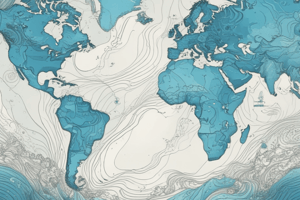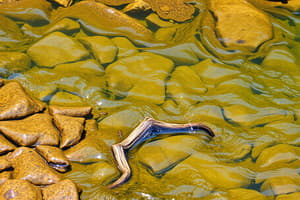Podcast
Questions and Answers
What is the property of water that allows it to mingle with other elements?
What is the property of water that allows it to mingle with other elements?
- Its density
- Its temperature
- Its color
- Its solvent capabilities (correct)
The majority of the heat transferred from the atmosphere to the earth is transferred by?
The majority of the heat transferred from the atmosphere to the earth is transferred by?
absorption by the lithosphere
What are the two main factors controlling the density of water?
What are the two main factors controlling the density of water?
salinity and temperature
At what temperature does the maximum density of pure water occur, and why?
At what temperature does the maximum density of pure water occur, and why?
What is the zone of rapid temperature change called?
What is the zone of rapid temperature change called?
The density of air increases with what?
The density of air increases with what?
What is the Coriolis effect?
What is the Coriolis effect?
Winds are designated from which direction?
Winds are designated from which direction?
Gyres are divided into currents termed below, except?
Gyres are divided into currents termed below, except?
The thermocline is a boundary between layers of water with differing what?
The thermocline is a boundary between layers of water with differing what?
If the earth consistently absorbed more energy from the sun than it radiated into space, what would happen?
If the earth consistently absorbed more energy from the sun than it radiated into space, what would happen?
What causes convection cells?
What causes convection cells?
What causes the Coriolis effect?
What causes the Coriolis effect?
Where are trade winds found and what direction do they blow towards?
Where are trade winds found and what direction do they blow towards?
Where are polar easterlies found and in what direction do they blow?
Where are polar easterlies found and in what direction do they blow?
Would you expect the water at the ocean's surface near a desert to have higher or lower salinity compared to the average ocean salinity?
Would you expect the water at the ocean's surface near a desert to have higher or lower salinity compared to the average ocean salinity?
What is the primary force that provides energy for surface currents?
What is the primary force that provides energy for surface currents?
How many gyres are found in each major ocean basin?
How many gyres are found in each major ocean basin?
Which ocean gyre has a tendency to flow in a northward direction?
Which ocean gyre has a tendency to flow in a northward direction?
What causes deep circulation?
What causes deep circulation?
What percent of ocean water is pure water?
What percent of ocean water is pure water?
What is the process by which deep, nutrient-rich water moves upward to replace surface water blown farther offshore?
What is the process by which deep, nutrient-rich water moves upward to replace surface water blown farther offshore?
Deep Atlantic currents are formed largely as a result of what?
Deep Atlantic currents are formed largely as a result of what?
What are convection cells?
What are convection cells?
In what region do the northeast and southeast trade winds meet?
In what region do the northeast and southeast trade winds meet?
Why does the sun heat the Earth unevenly?
Why does the sun heat the Earth unevenly?
What direction do transverse currents flow?
What direction do transverse currents flow?
What is the direction of eastern-boundary currents?
What is the direction of eastern-boundary currents?
Explain downwelling.
Explain downwelling.
Flashcards are hidden until you start studying
Study Notes
Properties of Water
- Water acts as a solvent, allowing it to mingle with various substances.
- The maximum density of pure water occurs at 4 degrees Celsius; below this temperature, water freezes.
- The density of air increases with increasing moisture, affecting atmospheric conditions.
Heat Transfer
- Most heat transfer from the atmosphere to the Earth occurs through absorption by the lithosphere.
- If Earth absorbed more solar energy than it radiated, temperatures would rise continuously.
Water Density Factors
- Water density is primarily controlled by salinity and temperature, influencing aquatic ecosystems.
Thermocline and Circulation
- The thermocline is a layer in the ocean where temperature changes rapidly, distinguishing water layers.
- Upwelling is the process where nutrient-rich water rises to replace surface water, enhancing marine productivity.
Wind Patterns and Currents
- The Coriolis effect causes the apparent deflection of air paths due to Earth's rotation, influencing weather patterns.
- Wind designations are made based on the direction from which they originate.
- Trade winds blow toward the equator from 0 to 30 degrees latitude, while polar easterlies flow toward the equator from 60 to 90 degrees latitude.
Oceanic Gyres
- There are five major ocean gyres, each corresponding to a specific ocean basin, with the North Atlantic gyre typically flowing clockwise.
- Gyres consist of currents divided into various categories, excluding the Ekman spiral.
Currents and Convection
- Primary energy sources for surface ocean currents include wind.
- Convection cells in the atmosphere arise from warm air rising and cool air flowing in to replace it, creating circular wind patterns.
Salinity Variations
- Ocean water near deserts tends to have higher salinity compared to average ocean salinity due to increased evaporation rates.
Ocean Composition
- Approximately 96.5% of ocean water is pure water, emphasizing the concentration of dissolved salts and nutrients in the remaining portion.
Additional Current Patterns
- Transverse currents flow from west to east, and eastern-boundary currents flow from north to south toward the equator.
- Downwelling refers to the process of surface water sinking into deeper layers, affecting nutrient distribution and marine life.
Meeting Regions
- The doldrums are where the northeast and southeast trade winds converge, creating areas of low winds and instability.
Uneven Solar Heating
- The sun heats the Earth unevenly due to its spherical shape, axial tilt, and elliptical orbit, influencing climatic zones and weather patterns.
Deep Circulation
- Deep ocean currents result from the mixing of water masses with different densities, driven by temperature and salinity variations.
Studying That Suits You
Use AI to generate personalized quizzes and flashcards to suit your learning preferences.




